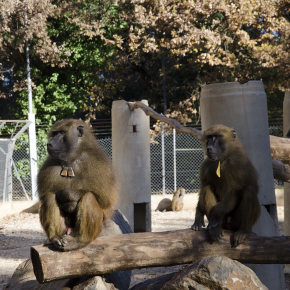
Experiment gives rise to social conventions between baboons
|
A research team from the CNRS and Aix-Marseille Université has demonstrated that members of a group of baboons can establish shared social conventions – in this case, by all agreeing on how to solve a problem in order to get a reward faster. This is the first time that such conventions have been studied experimentally in an animal species. The results of this groundbreaking work are published in Philosophical Transactions of the Royal Society B on 13 December 2021.
Kissing, shaking hands, or bowing are three possible ways of saying hello or goodbye. These gestures are social conventions: known to all individuals in a group, they allow one to address greetings quickly and appropriately. Conventions help solve coordination "problems" frequently encountered by the group, by providing efficient, stable and arbitrary solutions.
But conventions are not unique to the human species, as proven for the first time by the results of an experiment conducted at the CNRS primatology centre in Rousset-sur-Arc by researchers from the Cognitive Psychology Laboratory (CNRS/Aix-Marseille Université). Presented with a device requiring the coordination of two individuals, Guinea baboons established common rules for the whole group in about three days.
The baboons were presented with the following task: two different images were randomly selected from a set and presented on screens to two monkeys. If they wanted a reward, the baboons had to choose the same picture, meaning there was not one possible answer to the experiment, but several. Individuals had to decide together on a solution to the problem and agree on the choices to be made.
The primates quickly developed a hierarchy between images: for example, they agreed on the choice of the pink square when it was presented with a light blue square, and chose the yellow square next to a pink or light blue square. When the two baboons could no longer see each other, the overall performance of the group was hardly affected. This suggests that the baboons were not simply using imitation as a strategy to solve this problem, but had instead coordinated on these choices.
These conventions between baboons are stable over time, efficient, and arbitrary since the choice of images was not dictated. They therefore present the three characteristics of human social conventions. The scientists propose that groups of non-human primates in the wild be observed in new ways to detect such conventions.

© Anthony Formaux/Nicolas Claidière/LPC/CNRS
The experimental emergence of convention in a non-human primate. Anthony Formaux, Dany Paleressompoulle, Joël Fagot and Nicolas Claidière. Philosophical Transactions of the Royal Society B, 13 December 2021. DOI:10.1098/rstb.2020.0310


